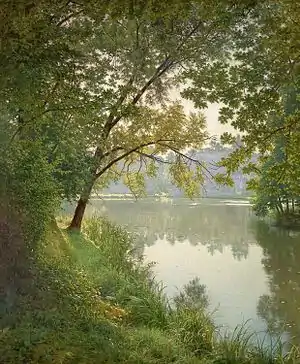| Matin à Villeneuve | |
|---|---|
| English: From Waters Edge | |
 | |
| Artist | Henri Biva |
| Year | c.1905 |
| Medium | Oil on canvas |
| Dimensions | 153.7 cm × 127 cm (60.5 in × 50 in) |
| Location | Private collection |
Matin à Villeneuve, also known as Villeneuve-l'Etang, le matin and From Waters Edge, is a painting created circa 1905 in the Realist tradition with a strong Naturalist component by the French artist Henri Biva (1848–1929). This work was photographed and reproduced as a black and white postcard published for the occasion of the Salon of 1906 in Paris.[1]
Description

Matin à Villeneuve is an oil painting on canvas in a vertical format with dimensions 153.7 x 127 cm (60.5 by 50 in), signed by Henri Biva (lower left).
This highly detailed work depicts a morning scene at the Villeneuve-l'étang park, located just outside Paris in the western suburb of Marnes-la-Coquette (Seine-et-Oise), France. The artist has chosen a quiet section of the park with a view facing towards the east. The greenery suggests the work was painted en plein air during July or August, and possibly finished sometime later in Biva's Parisian atelier.
Unlike works of the Neo-Impressionists or Fauves, in vogue at the time, Biva has gone to great lengths to show even the most minute details of the scene, such as leaves and petals floating on the surface of the water; overlapping blades of grass; superimposed branches and leaves of varying size indicating distance from the observer; reflecting background trees in the rippling body of water; patches of raking sunlit shimmering seemingly at random throughout carefully selected sections of the composition.
This work of skillfully controlled artistry presents a dominant palette of green variously mixed and blended by the artist to form diverse tones, values and hues, contrasted only by the transpiercing light of the morning sky partly visible through the delicate foliage while bouncing off the surface of the shallows.
Naturalism
A trace of Biva's meticulous and rigorous professors at the École des Beaux-Arts in Paris—Léon Tanzi (1846-1913), an esteemed Realist painter and Alexandre Nozal (1852-1929) a respected landscape artist—can be contemplated in Biva's work.
Janet Whitmore writes of Henri Biva's work, something that could apply to many of his paintings:
"Like the naturalist painters such as Jules Bastien-Lepage or Rosa Bonheur", writes Janet Whitmore, "there is a strong tactile quality to Biva’s work, focused on the shapes, colors and forms of the small plants beside the stream or the smooth grey surface of the tree trunks". Equally important, she writes, "this type of landscape painting offered an intimate glimpse of a specific locale, a reminder of days spent in the French countryside, or perhaps at the immense forest preserves surrounding Paris. Unlike contemporaries such as Pissarro or Monet, Biva’s landscapes suggest a time before industrialization when no railroad or factory disrupted rural vistas. Rather, these images show no evidence of human activity at all except for the occasional fisherman drowsing by the riverside. (Janet Whitmore, Ph.D.)[3]
Related works
 Henri Biva, Aprés-midi à Villeneuve-l'Etang, Salon 1906, postcard
Henri Biva, Aprés-midi à Villeneuve-l'Etang, Salon 1906, postcard Henri Biva, Le Matin embrumé à Villeneuve-l'Etang, Salon de Paris, 1910 postcard
Henri Biva, Le Matin embrumé à Villeneuve-l'Etang, Salon de Paris, 1910 postcard%252C_Salon_1911_postcard.jpg.webp) Henri Biva, Fin de journée, Villeneuve-l'Etang (The evening), Salon 1911 postcard
Henri Biva, Fin de journée, Villeneuve-l'Etang (The evening), Salon 1911 postcard Henri Biva, Sur le Pont de Villeneuve, Temps couvert, Salon de Paris postcard published 1914
Henri Biva, Sur le Pont de Villeneuve, Temps couvert, Salon de Paris postcard published 1914
Notes and references
- ↑ Loan exhibition of paintings owned by residents of Rochester: the Memorial Art Gallery (1914), University of Rochester, Book contributor: Cornell University Library
- ↑ Henri Biva, Matin à Villeneuve, Salon 1906, Vintage postcard
- ↑ Janet Whitmore, Ph.D., a biography of Henri Biva Archived 2011-11-05 at the Wayback Machine